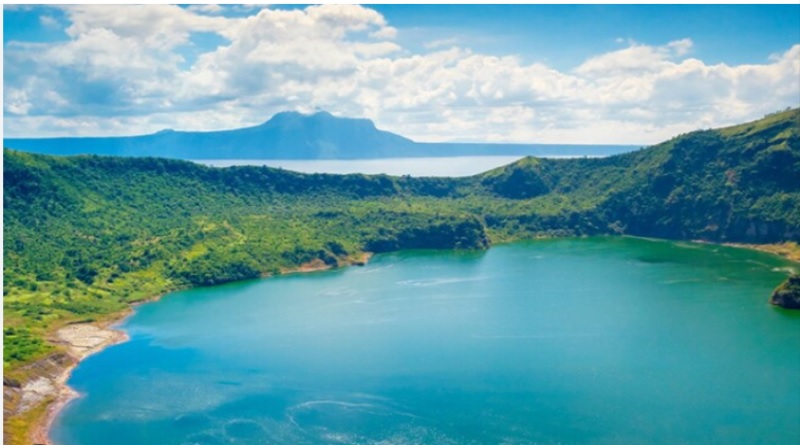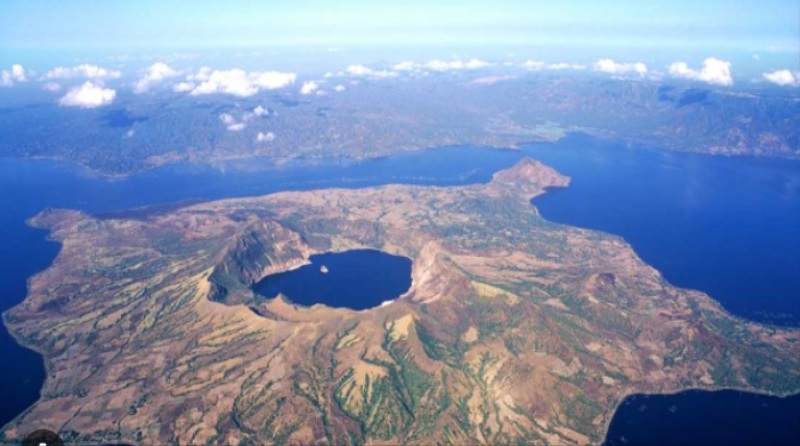Taal Lake – A Geologic Marvel.

Delhi: Taal Lake, located in the province of Batangas in the Philippines, is a geologic marvel that captivates the imagination of all who behold it. At the heart of this natural wonder lies Taal Volcano, one of the world’s smallest yet most active volcanoes, perched on an island within the lake. This geological masterpiece paints a mesmerizing picture of nature’s extraordinary power and beauty.
Taal Volcano’s unique feature lies in its nested craters. The main crater holds a serene Crater Lake, with hues that can change from deep green to vibrant red, offering a striking visual spectacle. These colors are a testament to the ever-evolving state of this volcanic system.
While Taal Lake is celebrated for its scenic beauty, it is more than just a tourist hotspot. This natural wonder holds cultural and environmental significance that enriches the lives of both local communities and global admirers.
The lake and its surrounding areas host a wide range of flora and fauna, supporting biodiversity crucial for ecological balance. The lake is home to various fish species, and the wetlands surrounding it serve as vital habitat for migratory birds.
The towns and communities around Taal Lake carry rich historical and cultural legacies, adding depth to the region’s allure. Traditional Filipino architecture, cuisine, and customs are preserved and celebrated in this culturally vibrant setting.
Myth and Mystery: Taal Lake’s charm is steeped in local folklore and legend. It’s said to have been formed from the tears of a grief-stricken giant who cried after losing his beloved. The lake’s islands, including the renowned Volcano Island, are believed to have risen from his submerged grave, adding an air of enchantment to the landscape.
The Beauty Unveiled: Taal Lake’s beauty is both soothing and awe-inspiring. The glistening water stretches as far as the eye can see, while the majestic Taal Volcano, with its ever-changing Crater Lake, stands proudly in the center. From the verdant hills to the placid waters and the lush, tropical vegetation, the setting is nothing short of a postcard-perfect paradise.

Fascinating Facts:
- Active Volcano: At its heart, Taal Lake harbors Taal Volcano, often dubbed the “world’s smallest active volcano.” Its ongoing volcanic activity, marked by periods of eruptions and restlessness, has both thrilled and concerned residents and scientists alike.
- Island within an Island: The Taal Volcano rests within Volcano Island, which is itself within Taal Lake, creating a geological wonder that’s a marvel to behold. The nested craters add to the intrigue and visual splendor.
- Biodiversity Hub: Taal Lake and its surroundings are a hotspot of biodiversity, with various fish species inhabiting its waters and the wetlands offering a refuge for migratory birds. The lake plays a crucial role in sustaining local ecosystems.
- Tourist Attraction: Taal Lake has earned a reputation as a popular tourist destination. Travellers come to explore the natural beauty, hike up to the volcano’s rim, or take boat rides on the lake, all while enjoying the picturesque scenery.
- Historical and Cultural Significance: Beyond its geological marvels, the region has a rich cultural history. It’s dotted with towns and communities preserving Filipino heritage, including traditional architecture, cuisine, and customs.
- How to reach Taal Lake from Delhi.
- By Air:
- Fly from Indira Gandhi International Airport in Delhi to Ninoy Aquino International Airport in Manila, Philippines.
- From Manila, take a domestic flight to Ninoy Aquino International Airport (also known as Manila Domestic Airport).
- From there, hire a taxi or take a bus to reach Taal Lake, which is approximately 60-70 kilometers south of Manila.
- By Sea and Land:
- Take a flight from Delhi to Manila.
- From Manila, head to a nearby port, like Batangas Port, where you can catch a ferry to the Taal Lake area.
- Upon reaching the port at Taal Lake, use local transportation or hire a taxi to get to your specific destination.





